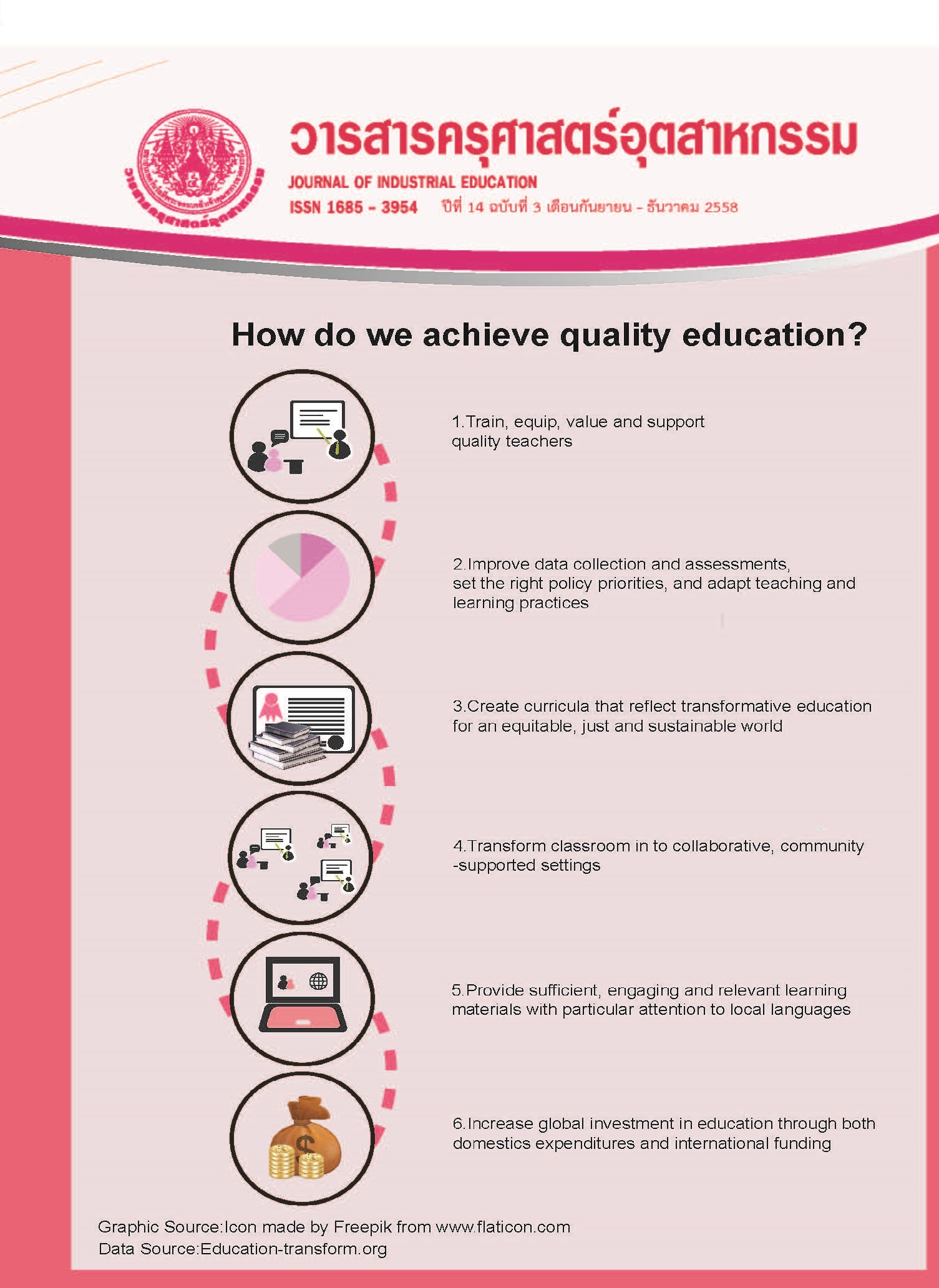A Development of Game-Based E-Learning Courseware on Flowchart
Main Article Content
Abstract
The objectives of this study were 1) to develop and find efficiency a game-based e-learning courseware on Flowchart and 2) to compare learning achievements between the students learning with the courseware and the student learning with the conventional instruction. The samples of the study comprised 152 seventh grade students enrolling Fundamental Programming at Suankularb Wittayalai School, Rangsit in the academic year 2/2014, selected by cluster random sampling method. The research instruments included a game-based e-learning courseware on Flowchart, quality evaluation form of e-learning courseware and a 20-item learning achievement test with Item Object Congruence Index = 0.67-1.00, Difficulty Index = 0.20-0.80, Discrimination = 0.27-0.73 and Reliability = 0.76.
The results showed that 1) the content quality ( = 4.81 and S.D. = 0.40) and media production quality (
= 4.79 and S.D. = 0.42) of the game-based e-learning courseware were at excellent level, with efficiency E1/E2 = 81.52/82.24 and 2) learning achievement of the student learning with the game-based e-learning courseware ( = 16.37) was significantly higher than the students learning with the conventional instruction (
= 14.66) at .05 level.
Article Details
"The opinions and contents including the words in papers are responsibility by the authors."
"ข้อคิดเห็น เนื้อหา รวมทั้งการใช้ภาษาในบทความถือเป็นความรับผิดชอบของผู้เขียน"
References
[2] กรมวิชาการ. 2551. หลักสูตรการศึกษาขั้นพื้นฐาน. พุทธศักราช 2551. กรุงเทพฯ : องค์การรับส่งสินค้าและพัสดุภัณฑ์.
[3] จินตวีร์ คล้ายสังข์. 2556. อีเลิร์นนิงคอร์สแวร์ แนวคิดสู่การปฏิบัติสำหรับการจัดการเรียนรู้อีเลิร์นนิงในทุกระดับ. กรุงเทพฯ: สำนักพิมพ์ แห่งจุฬาลงกรณ์มหาวิทยาลัย.
[4] สุกรี รอดโพธิ์ทอง. 2539. สู่เส้นทางแนวใหม่ทางการศึกษาคอมพิวเตอร์กับการศึกษา. กรุงเทพฯ : สำนักพิมพ์จุฬาลงกรณ์ มหาวิทยาลัย.
[5] ทิศนา แขมมณี. 2547. ศาสตร์การสอนองค์ความรู้เพื่อการจัดกระบวนการเรียนรู้ที่มีประสิทธิภาพ. กรุงเทพฯ: สำนักพิมพ์ จุฬาลงกรณ์มหาวิทยาลัย.
[6] Seels, B. and Glasgow, Z. 1998. Making Instructional Design Decisions. 2nd ed.Upper Saddle River, NJ: Merrill.
[7] ปิยะพงษ์ พุ่มประเสริฐ. 2555. การพัฒนา บทเรียนผ่านเครือข่ายอินเทอร์เน็ต เรื่อง การใช้อินเทอร์เน็ตและไปรษณีย์อิเล็กทรอนิกส์ เพื่อสืบค้นข้อมูลเพื่องานอาชีพ. วิทยานิพนธ์ ครุศาสตร์อุตสาหกรรมมหาบัณฑิต สาขาวิชา หลักสูตรและการสอนอาชีวศึกษา คณะครุศาสตร์ อุตสาหกรรม สถาบันเทคโนโลยีพระจอมเกล้า เจ้าคุณทหารลาดกระบัง.
[8] ชัยยงค์ พรหมวงศ์. 2550. การจัดการนวัตกรรมและเทคโนโลยีสารสนเทศและนวัตกรรมการเรียนการสอน. ค้นเมื่อวันที่ 1 กันยายน 2557, จาก https://www.portal.in.th
[9] Prensky, Marc. 2001. Digital Game-Based Learning. New York : McGraw Hill.
[10] Malone, T.W. 1980. A Study of Intrinsically Motivating Computer Games. ค้นเมื่อวันที่ 1 กันยายน 2557, จาก https://cci.mit.edu/ malone/tm%20study%20144.html
[11] Anderson, L. W. and Krathwohl, D. R. 2001. A taxonomy for learning, teaching, and assessing: A revision of Bloom’s taxonomy of educational objectives. New York : Longman.
[12] สุจิตรา ศรีฮาด. 2556. การพัฒนาบทเรียนคอมพิวเตอร์ช่วยสอนผ่านเครือข่ายอินเทอร์เน็ต เรื่อง ระบบคอมพิวเตอร์ วิทยาลัยเทคโนโลยีอักษรพัทยา. วารสารครุศาสตร์อุตสาหกรรม, 12(1), น. 42–48
[13] นพดล จักรแก้ว. 2556. การพัฒนาบทเรียนผ่านระบบเครือข่ายอินเทอร์เน็ตเพื่อการทบทวน เรื่อง ภาษาซี วิชา การเขียนโปรแกรมเชิงโครงสร้าง. วารสารครุศาสตร์อุตสาหกรรม, 12(2), น. 32-37
[14] กรรณิการ์ มักเจียว. 2556. การพัฒนาบทเรียนคอมพิวเตอร์ผ่านเครือข่ายอินเทอร์เน็ต เรื่อง การสร้างงานกราฟิกด้วยโปรแกรมสำเร็จรูป โรงเรียนนวมินทราชินูทิศสตรีวิทยา 2. วารสารครุศาสตร์อุตสาหกรรม, 12(1), น. 49-55

